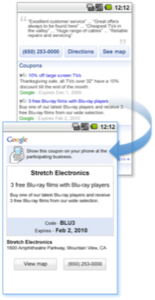The rapid growth of the mobile web is a force that could be disruptive to Google, a company that built its search engine for a desktop-based world. On the handheld, all bets are off. Anyone with an innovative concept for improving mobile search could gain ground, possibly even overtaking Google as the top search provider for mobile devices. But don’t worry – Google hasn’t been ignoring this trend. The company has been busy prepping various initiatives designed to get people googling from their mobile phones. From scannable barcodes to an innovative visual search app that lets you perform searches by taking photos, Google is slowly revealing how they plan to dominate search in the real world too.

Google Does Barcodes (Again)
Google hasn’t given up on barcode scanning just yet. Although a failed Print Ad program featuring barcodes for newspapers was shut down at the beginning of the year, that hasn’t stopped the company from giving barcodes another go. This time, the venue isn’t the old-fashioned newspaper, but local businesses. Through Google’s Favorite Places program, over 100,000 of the United State’s most popular local businesses will receive stickers sporting Google’s logo, a scannable barcode and a message reading, “We’re a favorite place on Google.” Business owners can post these decals to their store windows to show off their respectability and popularity – and you can bet many will.
Customers scanning the barcode will be taken to that store’s “place page” which reveals various details about the business, including hours of operation, reviews, photos, directions, phone numbers, brands carried, menus (if a restaurant) and even mobile coupons, if available. In addition, users can “star” (rate) the establishment and submit their own review, turning Google Local Businesses into a Yelp-like user-generated review service.

While this initiative has a better chance for success in introducing barcode-scanning to the United States market than the Print Ad program did, there’s still going to be some confusion on the part of consumers as to how to get started. Google notes in its Favorite Places FAQ that many modern smartphones including the iPhone, Blackberry, Droid and other Android devices offer barcode scanning applications, but no links or suggestions are provided. This leaves consumers with the problem of having to figure it out on their own. In addition, feature phone owners whose more basic devices include cameras may also wonder if there is software for their phones, too. In some cases there is, but the less tech-savvy mainstream user base has no way of discovering that without taking the time to do some research on the topic.
Perhaps Google should have introduced a cross-platform barcode-scanning application of its own? If it had, it could have definitely helped push the technology adoption forward. It’s almost surprising that it hasn’t yet done so, especially considering that its latest search rival, Microsoft, has. With Microsoft Tag, for example, you can create your own barcode-like “Tag images,” as well as download mobile, Tag-reading software.
Mobile Coupons
As mentioned above, the Favorite Places’ barcodes will link to pages that support mobile coupons, assuming the business chooses to offer them. However, these coupons aren’t limited to “favorite” businesses – any business listed on Google Local Search can use this feature. Announced late last month, Google introduced the mobile coupon feature to its Google Local Business Center program which lets any company offer coupons that consumers can access right from their mobile phone. At checkout, the shopper just needs to show the coupon on their mobile’s screen to receive the discount.

Visual Search via Mobile Photos
Google Visual Search is an upcoming technology that’s still in development. It was revealed on CNBC’s “Inside the Mind of Google” segment on December 3rd. This innovative mobile application aims to provide an even more intuitive way for interacting with the real world via your mobile phone. With Visual Search, users with phones running Google’s own mobile operating system, Android, will be able to take a photo of their location and use that to trigger a Google search. In order for this to work, advanced algorithms have to match the photo with those stored in a massive database on the backend.
Initially, this service could be used to provide information about various landmarks, businesses or other notable locales, but really the possibilities are endless. Eventually, the same technology that recognizes landmarks could recognize other objects, too, like products on store shelves, billboard ads or street intersections. It could even recognize people. As sci-fi as that sounds, that last technology already exists today. Other companies and startups working on facial recognition include Polar Rose, which identifies people in your Flickr and Facebook photos, Face.com, which offers two applications for identifying people in Facebook photos, a concept technology called Augmented ID, which does mobile-enabled facial recognition, and Apple’s iPhoto, which offers facial recognition, too. And, of course, so does Google’s own photo service, Picasa.
Google Knows Mobile is the Platform of the Future
While it’s true that any company has a shot at dominating the mobile platform, you can’t count out Google yet. It’s clear the company is aware of just how important this new platform is to the future of search, and it has been busy designing mobile technology to take advantage of this new trend. From GPS-enabled, turn-by-turn navigation applications, to voice-enabled mobile search apps, to all the technologies mentioned here, Google plans to become the king of mobile search just as it is the king of web search today.


















